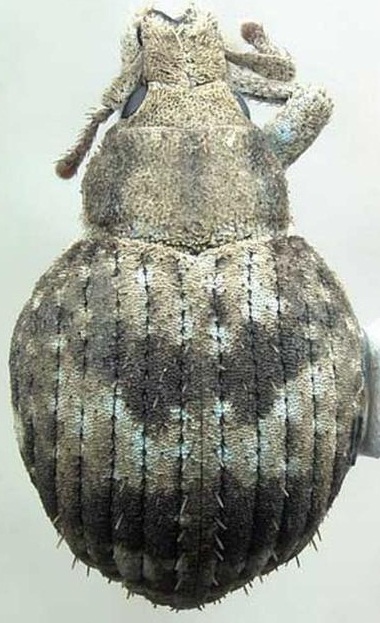Pseudocneorhinus bifasciatus
Twobanded Japanese Weevil
Synonym: Callirhopalus bifasciatus, Pseudocneorhinus setosus
Class: Insecta
Order: Coleoptera
Family: Curculionidae

Photographer: Dr. Michael Thomas
Source: http://edis.ifas.ufl.edu/in646
Adult Description: This pear-shaped flightless beetle has a short, blunt snout with elytra that are much broader than the pronotum. It is about ¼ inch long and is covered with brown and grey scales that form bands across the elytra. The elytra are fused together on this insect which is why it is flightless.
Larvae Description: White, legless larvae measuring about 7.5-8.5 mm. The pupa is white with yellow-brown setae and is 6.25mm long.
Host Plant: These weevils are known to feed on over 100 species of plants but only fully develop (eggs to adults) on a few plants; one being the multiflora rose (Rosa multiflora). Other hosts recorded are azalea (Rhododendron), privet (Ligustrum), cherry laurel (Prunus laurocerasus), Pyracantha, Euonymus, barberry (Barberis) , ash (Fraxinus), burr marigold (Bidens), Camellia, dogwood (Cornus), elm (Ulmus), fern, hemlock (Tsuga), holly (Ilex), lilac (Syringa), mountain laurel (Kalmia latifolia), rose (Rosa), Spirea, strawberry (Fragaria), Weigela, Koelreuteria, and Deutzia.
Ecological Threat: What makes this weevil more detrimental to ornamental plants is that both adults and larvae cause plant damage. Adults cause defoliation, whereas the larvae live in the soil and destroy the roots. Adults chew leaf tissues at the margins and create notches. Initial damage by the overwintering population of adults is quickly masked by rapidly growing spring populations, but severe defoliation can occur when new adults emerge. Past records show that twobanded Japanese weevils are capable of stripping privet (Ligustrum) hedges, 50 feet in length, and can cause irreparable damage to hemlocks. Typically, twobanded Japanese weevils are noticed only when large population cause extensive defoliation.
Biology: The twobanded Japanese weevils reproduce parthenogenically (meaning there are no males) and overwinter as adults, eggs or larvae. When warmer weather approaches the overwintered adults become active and start feeding again. Eggs are laid on leaf folds from May through October; with the peak oviposition period being from September to early October. By November the oviposition stops. Eggs hatch in 14-18 days and the newly hatched larvae drown to the ground and burrow into the soil to feed on the roots. Larvae have been found at depths from 1-9 inches under the surface. After the larvae pupate they emerge a s adults and return to the top surface to feed on the host plant.
History: Pseudocneorhinus bifasciatus, first collected in the United States in 1914 near Philadelphia, was most likely introduced with infested nursery stock from Japan. The weevil was first collected in North Carolina in 1955, Georgia in 1959, South Carolina in 1966 and Alabama in 1970. Its presence in Florida was confirmed in July 2005. Since the weevil is flightless, it is unlikely to spread to long distances by jumping. Therefore the spread in the southeastern states is possibly due to the movement of infested ornamental plants.
U.S. Habitat: Ornamental plants like multiflora rose, other roses, azaleas, hemlocks and privets
Distribution
Native Origin: China, Japan, Korea, Mongolia, and eastern Siberia
U.S. Present: AL, CT, GA, FL, IL, IN, MA, ME, NC, NH, NY, RI, SC, VA and VT
Management
Twobanded Japanese weevils can drop from infested shrubs when disturbed and many can be trapped and destroyed. Taking care not to jar the plant, place a white cloth or large sheet of paper under the shrub and then tap or shake the plant vigorously. Many weevils will fall off and can be easily collected. Destroy the weevils by dropping them into a can of water with a small amount of solvent or by freezing them or some other method.
Pseudocneorhinus bifasciatus are apparently resistant to carbaryl (Sevin), diazinon, and malathion. Two small demonstrations conducted in 1981 indicated that acephate (Orthene) at the labeled rate gave good control when applied as a foliar spray and drench. Azatin EC is specifically labeled with a full Federal registration for the twobanded Japanese weevil although this pest is not listed on the label.
Commercial growers and landscapers can use a pyrethroid (Astro, Mavrik, Talstar or Tempo 2) for control. Homeowners may find BioNeem and formulations of cyfluthrin or permethrin at lawn and garden centers. It is best to spray tree trunks, branches, and foliage during the second or third week of June, but trees can be treated whenever the weevils are seen. Products containing imidacloprid should provide effective control if applied as a soil drench just as growth starts in the spring.
Text References
Boyd Jr DW, Wheeler Jr AG. 2004. The two banded Japanese weevil, Pseudocneorhinus bifasciatus (Roelofs) (Coleoptera: Curculionidae): Southeastern U.S. distribution of an adventive pest of ornamental shrubs. In Oliver J. (Section Editor), Entomology Section. SNA Research Conference, Vol. 49. pp. 192-194.
Marrone PG, Zepp DB. 1979. Descriptions of the larva and pupa of Callirhopalus (subg. Pseudocneorhinus) bifasciatus, the two banded Japanese weevil, with new host plant records. Annals of the Entomological Society of America 72: 833-836.
Wheeler AG, Boyd Jr DW. 2005. Southeastern U.S. distribution of an invasive weevil, Pseudocneorhinus bifasciatus Roelofs (Coleoptera: Curculionidae). Journal of Entomological Science 40: 25-30.
Internet Sources
http://entnemdept.ifas.ufl.edu/creatures/orn/beetles/twobanded_Japanese_weevil.htm
http://www.ces.ncsu.edu/depts/ent/notes/O&T/shrubs/note34/note34.html
http://pubs.ext.vt.edu/444/444-624/444-624.html
http://edis.ifas.ufl.edu/in646
 Texas Invasive Species Institute
Texas Invasive Species Institute